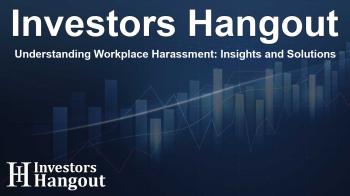Understanding Workplace Harassment: Insights and Solutions

Understanding Workplace Harassment: Insights and Solutions
The prevalence of workplace harassment is a pressing issue that many organizations must address proactively. A recent survey conducted by Traliant offers significant insights into the experiences of employees regarding harassment in their work environments. This survey, which engaged over 2,000 full-time employees across various sectors, highlights a stark reality: nearly half of the participants reported witnessing harassment during their time in the workplace.
Survey Statistics on Workplace Harassment
According to the findings, approximately 46% of employees indicated they have observed harassment directed at fellow workers, while about 24% admitted to being targets of such misconduct themselves. These alarming figures call into question the effectiveness of existing harassment prevention measures within organizations.
Generational Differences in Reporting
Interestingly, the survey underscores generational disparities in experiences related to workplace harassment. A striking 52% of Gen Z employees shared that they had witnessed harassment, contrasted with only 33% of Baby Boomers. This difference highlights the changing dynamics and challenges among the younger workforce, which necessitates targeted strategies to address their unique experiences and needs.
Barriers to Reporting Harassment
Another critical insight from the survey reveals substantial barriers faced by employees when considering reporting harassment incidents. Notably, only 51% of respondents were willing to report harassment if they had to disclose their names, indicating a lack of confidence in confidentiality and safety in reporting procedures. Additionally, 49% expressed concerns that they would refrain from reporting due to fears of retaliation or potential harm to their reputation.
Satisfaction with Reporting Outcomes
Furthermore, the report shed light on the dissatisfaction levels regarding the handling of harassment claims. For instance, 32% of female respondents expressed dissatisfaction with how their complaints were managed, compared to 20% of male respondents. This discrepancy illustrates the need for organizations to improve their response mechanisms to foster a more trusting environment.
Creating a Safer Workplace Culture
Michael Johnson, the Chief Strategy Officer at Traliant, emphasized the urgent need for employers to act. By prioritizing harassment prevention and ensuring employees have access to essential resources, organizations demonstrate a commitment to fostering a safe and supportive workplace. Preventive measures should include effective training programs aimed at educating employees on identifying harassment, as well as clear reporting mechanisms that enhance confidentiality.
The Role of Training in Prevention
Traliant's dedication to tackling these issues is crucial. Their approach involves incorporating engaging online training that motivates employees. With a focus on compliance and empowerment, organizations can reshape their workplace culture to be more inclusive and safe for all. Continuous education and awareness are vital components that help prevent potential harassment situations before they escalate.
Moving Forward: Implementing Effective Solutions
To address the issues unveiled by this survey, companies should undertake comprehensive assessments of their current policies and training programs. Engaging employees in conversations about their experiences can also provide invaluable insights and aid in building trust within the workforce. Furthermore, organizations must revamp their reporting processes, ensuring they are robust, clear, and confidential.
Commitment to Change
Ultimately, the findings from Traliant’s survey emphasize that workplace harassment is not only a legal issue but also a moral imperative. Companies that prioritize creating safe working environments are more likely to retain talent and foster positive employee morale. This commitment to improvement positions organizations as leaders in both workplace safety and employee satisfaction.
Frequently Asked Questions
What is the primary finding of Traliant's survey on workplace harassment?
The survey revealed that nearly half of employees have witnessed harassment, indicating a significant issue within organizations.
How do generational differences impact experiences of workplace harassment?
Gen Z employees reported higher instances of witnessing harassment compared to Baby Boomers, suggesting different experiences among generations.
What barriers do employees face in reporting harassment?
Employees face barriers such as fear of retaliation and a lack of confidence in confidential reporting channels, impacting their willingness to report incidents.
What measures can organizations adopt to improve workplace safety?
Organizations should implement comprehensive training programs, enhance reporting mechanisms, and foster open discussions regarding harassment.
Why is it essential for companies to address workplace harassment?
Addressing workplace harassment is crucial for legal compliance, employee well-being, and maintaining a positive organizational culture.
About Investors Hangout
Investors Hangout is a leading online stock forum for financial discussion and learning, offering a wide range of free tools and resources. It draws in traders of all levels, who exchange market knowledge, investigate trading tactics, and keep an eye on industry developments in real time. Featuring financial articles, stock message boards, quotes, charts, company profiles, and live news updates. Through cooperative learning and a wealth of informational resources, it helps users from novices creating their first portfolios to experts honing their techniques. Join Investors Hangout today: https://investorshangout.com/
Disclaimer: The content of this article is solely for general informational purposes only; it does not represent legal, financial, or investment advice. Investors Hangout does not offer financial advice; the author is not a licensed financial advisor. Consult a qualified advisor before making any financial or investment decisions based on this article. The author's interpretation of publicly available data presented here; as a result, they should not be taken as advice to purchase, sell, or hold any securities mentioned or any other investments. If any of the material offered here is inaccurate, please contact us for corrections.
